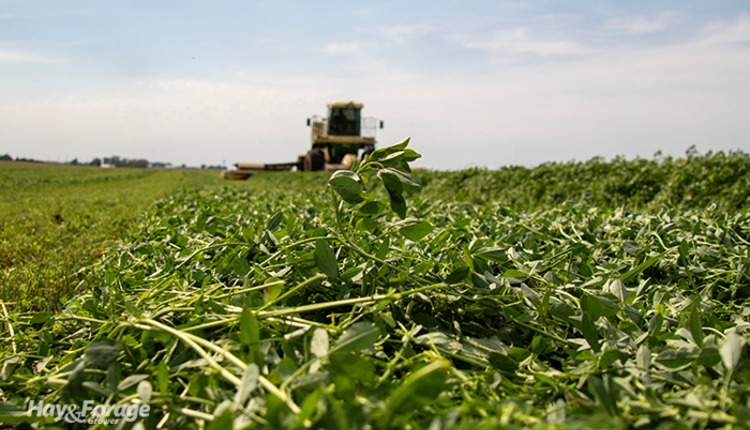
Another flip of the calendar means the first cutting of alfalfa is fast approaching for many farmers. The outcome of this initial harvest will set the tone for the rest of the growing season, but the past few months of questionable conditions might throw a wrench into the rhythm of chopping or baling.
By now, the seemingly perpetual stretch of unseasonably warm weather has likely given producers enough time to ponder the possibility of alfalfa winterkill in their fields. Evaluating root color and structure will be as important as taking stem counts and monitoring aboveground growth once plants green up.
Whether the verdict of a stand assessment is positive or negative will influence how to move forward with first cutting. In the latter instance, making the most of weakened stands will demand a balance of managing environmental stress and fine-tuning production practices.
Shelby Gruss ranked the top three concerns she has entering the spring harvest season with potentially damaged alfalfa in a recent episode of the Dairy News and Views podcast from Iowa State University. The state forage specialist is primarily focused on the impact dry soils could have on forage regrowth, followed by hitting quality targets for first cutting and estimating hay needs after alfalfa breaks dormancy.
Dry soil setbacks
Gruss noted dry soil conditions during the fall and winter may have put alfalfa in a better position to survive freezing temperature fluctuations. Less free water in forage reduces the chance that ice crystals will pierce plant cells, enhancing the winterhardiness of alfalfa. With that said, dry soil conditions that persist into the spring could compromise plant growth.
Luckily, alfalfa’s long taproot makes it incredibly drought resistant, reaching down several feet to scavenge water from deep in the soil profile. While this is the case for healthy plants, the power of the taproot may be less pronounced in alfalfa that has experienced winter injury, as well as older plants. Young seedlings will also not be equipped to tolerate dry soil conditions — if they are even able to germinate at all.
Instead of establishing new alfalfa stands this spring, aim to maintain current stands that already have reliable roots. Gruss justified terminating extremely poor and unproductive stands, but otherwise she encouraged producers to take advantage of existing ones.
“Let’s think about keeping stands that will be more drought resilient moving forward,” she said. “I think that is a great opportunity to maximize on one of the most drought tolerant plants we’ve got.”
Interseeding grasses or clovers into alfalfa can enhance persistence, yield, and/or quality of weaker stands in the future, depending on the forage species being introduced. Moreover, Gruss recommended extending the second, third, or fourth cutting of alfalfa by five to seven days to reinforce root reserves that may have been expended over the winter.
Prioritize quality
Forage yield and quality are often pitted against each other since prioritizing one can impede the other. That said, it can be tempting to delay first cutting to gain greater tonnage, especially to make up for lower yields in damaged fields. But this is not the time to gamble with good forage quality.
Gruss noted that the first cutting can provide up to 50% of a hayfield’s total yield across all harvests. This means half of a year’s worth of hay can be high quality — or not — depending on harvest timing. What’s more is alfalfa accumulates dry matter faster in the spring and early summer than it does later in the growing season, emphasizing the importance of a well-timed first cut so not to waste an opportunity to harvest high-value feed.
Using predicted equations for alfalfa quality (PEAQ) and growing degree days (GDD) are the most accurate methods to determine forage quality for first cutting. Gruss noted factors like rainfall, soil conditions, and fall dormancy rating of alfalfa will influence PEAQ values, and having access to a weather station or field thermometer will be critical to calculate GDD.
Think big picture
Evaluating alfalfa after stands green up and accounting for winter injury will guide reseeding practices and harvest timing. Additionally, stand assessments should prompt producers to map out their feeding plans and determine how much hay or haylage they need to make or purchase to sustain their livestock for the next several months.
Alfalfa may not pass stand assessments with flying colors this spring for a few reasons. For one, Gruss noted many examples of alfalfa greening up early from mid-December to late February across the Hawkeye State. A sudden drop in temperature following these events may have been detrimental to plants.
“Every time it greened up, if the plant didn’t have the chance to go through winter hardening again and prepare for a cold drop, those plants were more susceptible to winter damage,” Gruss explained.
In addition to sudden drops in temperature, a couple of weeks of freezing cold gripped a large portion of the Midwest in mid-January. Without adequate snow cover, this arctic air could have damaged unprotected plants as well. And despite the temperatures and snowfall in specific areas, Gruss speculated that accumulated drought stress from previous growing seasons will be an overarching factor for widespread winterkill this year.
Gruss summed up the worst-case scenario for this spring in two words: freezing rain. As warm weather draws alfalfa out of dormancy and invites plants to resume active growth, the biggest risk will be the return of cold temperatures and moisture that terminate new buds. The best-case scenario, on the other hand, will be mild weather and adequate rainfall to restore soil moisture without adding to the uncertainty of the upcoming harvest season.

